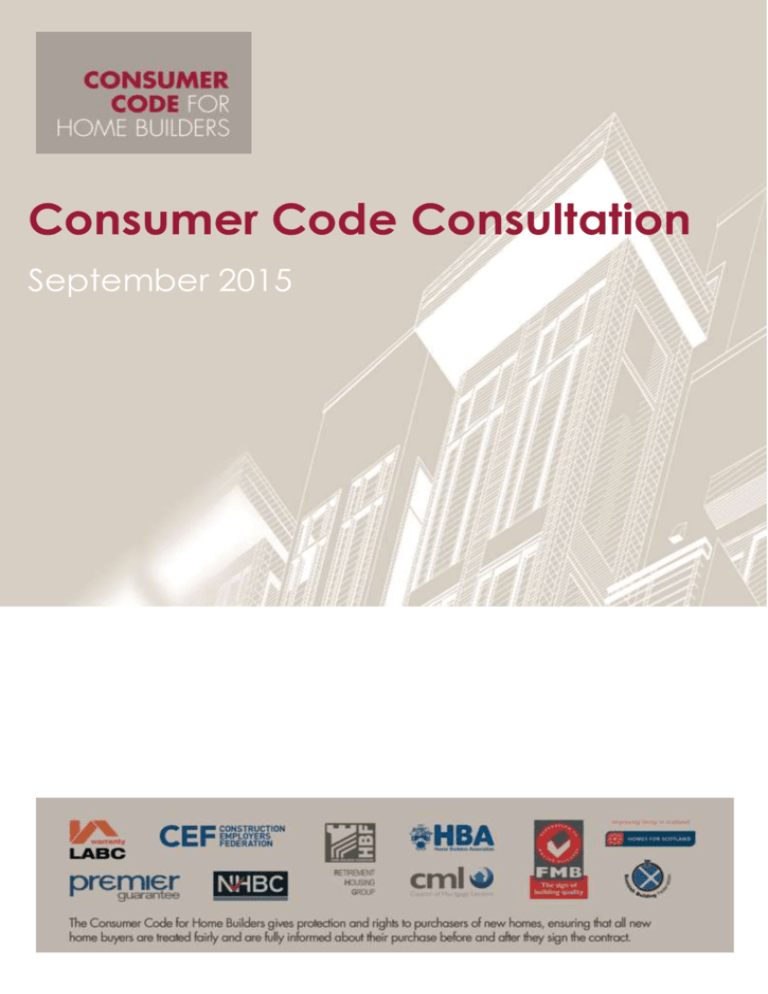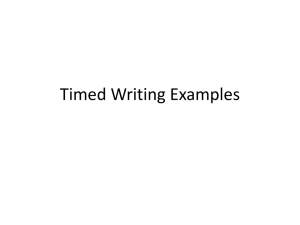September 2015 - Consumer Code for Home Builders
advertisement

Consumer Code Consultation September 2015 CCHB Code Review September 2015 1 1. Introduction The Consumer Code for Homebuilders is an industry led code of conduct for builders, which was developed to make the home buying process fairer and more transparent for purchasers. The Code applies to all homebuilders registered with the UK's main new home warranty providers; NHBC, Premier Guarantee and LABC Warranty and consists of 19 requirements and principles that home builders must meet in their marketing and selling of homes and their after-sales customer service. The Code came into effect on 1st April 2010 since when it has been providing protection and rights to purchasers of new homes, ensuring that all new Home Buyers are treated fairly and are fully informed about their purchase before and after they sign the contract. The Code reinforces best practice among Home Builders to make sure the level of information and customer service provided by all Home Builders is consistently high. It builds on successful efforts already made by the industry to improve consumer satisfaction in recent years. During the first four years of operation of the Code, I have been enormously impressed by the commitment of the leaders of the Home Building Industry to ensure it has the priority and prominence it deserves. This commitment has been matched by many companies, both large and small, throughout the UK and as a result, the Code continues to play a significant role in ensuring consumer confidence remains high. The credibility of the Code has been recognised by the ‘Help to Buy Scheme’ in England and Scotland, with the requirement that the terms of the Code should be observed by home builders promoting Help to Buy. However, as the Code enters its fifth year, the Management Board1 know it is important not to become complacent about the challenges the Code faces if it is to remain credible, visible and relevant to consumers and continues to be an important priority for the Industry. Noel Hunter (OBE) Chairman; Mike Freshney – Chairman of Advisory Forum; Ian Davis – Operations Director of NHBC; Gary Devaney – Group Chairman and CEO of MD Insurance Ltd; Philip Hogg – CEO of Homes for Scotland and Sue Green, Manager of Stratford Upon Avon and District Citizens Advice 1 CCHB Code Review September 2015 2 Market research has been conducted annually since the inception of the Code and there is some evidence of a reduction in awareness levels, notably at the first point of contact with the Home Buyer and amongst estate agents who work on behalf of Home Builders. Whilst both the Industry and estate agents have invested significantly in staff training, it is inevitable that the churn of staff in the Industry makes this an on going priority. There is also a year-on-year increase in the overall number of cases that have been referred to the Code’s Independent Dispute Resolution Scheme. While this may be as a result of the higher volume of houses being built across the UK, the indications are that more cases are succeeding either in part or fully, in favour of the Home Buyer. This may indicate that compliance with the Code has fallen short in some measure. Furthermore, the Code is looking to gain approval through the Chartered Trading Standards Institute’s (CTSI) Consumer Codes Approval Scheme, which has succeeded the previous Office of Fair Trading scheme. This facilitated selfregulation aims to bolster consumer protection and improve customer service standards by the approval and promotion of codes of practice; setting out the principles of effective customer service and recognising approved traders. In return, consumers can look out for the CTSI approved code logo when searching for a trader, and be confident that any approved business they choose has a proven commitment to honest business and higher customer standards, such an application may require revisions to the Code’s requirements. The Code’s Management Board wishes to seek the views of Home Builders, trade bodies and all other stakeholders on the overall scope, operation and impact of the Code as detailed within this consultation. We look forward to seeing responses from all of those with an interest in the Code and to ensuring it remains relevant to the home building industry, consumers and other key stakeholders. Noel Hunter OBE Chairman Consumer Code Management Board CCHB Code Review September 2015 3 2. Purpose The purpose of this consultation is to seek the widest possible perspective on the Code to ensure it retains and builds upon the strengths of the current requirements, and support of the Industry, ensuring it remains both viable and credible when reducing consumer detriment in the new home buying market. Responses to this consultation will inform any revisions to future changes of the Code and seeks views on those proposed as a result of feedback already received by the Code’s Management Board. The aim is ensure the Code continues to meet the needs of Home Buyers in terms of driving up industry standards and customer satisfaction in the new home buying market. 3. Current Code Provision and Case for Change After its launch, the Code was originally reviewed in 2012 and changes were made as a result of the feedback received. The Code is now in its third edition. However, in light of a further two years’ experience of operating the Code and feedback from our mystery shopping; adjudications from our Independent Dispute Resolution Scheme; discussions with stakeholders and applicants to become a User of the Code, the Code’s Management Board have committed to a further review in 2015 for implementation of any changes required in 2017. In addition, we are aware from the requirements contained within the core criteria, that to meet CTSI’s Consumer Codes Approval Scheme, we will need to revise and enhance the Code in specific areas. The proposals for change are outlined in more detail below taking into account those requirements. The review is also an opportune time to consider whether there is anything contained within the Code that either could/should be removed given it was launched some five years ago and requirements/developments may have moved on since then. 4. Proposals for change As outlined above, there are a number of drivers behind reviewing the Code and the examples of proposed changes are offered to prompt thought and discussion, as we want to hear what you think. CCHB Code Review September 2015 4 To assist with the co-ordination of responses, we ask that you provide your feedback and views using the attached questionnaire. The proposals are broken down into three areas: 1. The Consumer Code requirements and the non-mandatory good practice guidance for Home Builders. 2. Revisions required in light of the application to CTSI Consumer Codes Approval Scheme. 3. General Code matters including: the operation of the Adjudication Scheme; the arrangements for monitoring and auditing compliance with the Code; the material available on the Code website and the governance arrangements including the application process for new warranty bodies and the assessment of New Home Cover in the market place. A summary of all the questions posed can be found in section 4 (page 25) CCHB Code Review September 2015 5 Section 1 Proposed revisions to the Consumer Code requirements and the nonmandatory good practice guidance for Home Builders 1. Code Introduction Contained within the introduction of the Code, paragraph 5 explains the Home Warranty Bodies have agreed to require all their registered builders to adopt and comply with the Code as a registration condition. If a Home Builder is found to be in serious breach of the Code, Home Warranty Bodies can apply a range of sanctions. These include removal from the relevant Home Warranty Body’s register and exclusion from all registers run by other Home Warranty Bodies that take part in the Code scheme. Given that other Home Warranty Bodies have been approved under CTSI’s Consumer Codes Approval Scheme, it is proposed to extend the exclusion from all registers run by Home Warranty Bodies that take part in the Code Scheme or CTSI’s scheme. This is to prevent Home Builders from “Code or Warranty hopping” should they fail to meet the requirements. Q 1. Do you agree with this approach? Please say if not why not and what difficulties you might perceive. Conversely, what benefits do you perceive by extending the exclusion to other warranty bodies operating under CTSI’s scheme? 2. Making the Code Available Section 1.2 of the Code requires Home Builders to display the Code (for example in sales packs, in public places such as site offices or on a Home Builder’s website) and give, without charge, a copy to customers who ask for it CCHB Code Review September 2015 6 and to all Home Buyers who reserve a home. The guidance to home builders says that the Code should also be clearly displayed and says that in doing so it may be “made available on your website”. It is clear from mystery shopping and customer surveys that many consumers and Home Buyers are not aware of the Code. To maximize awareness and distribution of the Code it is proposed that the visible display of the Code in Site Sales and Estate Agents offices at the point of sale be mandatory. Q 2. Do you agree with these proposals in relation to making the Code more visible within site sales offices/at the point of sale? Please explain your answer, saying what difficulties you foresee in complying and further, what you think could be done to raise (or maximise) awareness of the Code. 3. Appropriately trained customer service staff Section 1.4 of the Code requires Home Builders to provide suitable training to all staff who deal with Home Buyers about their responsibilities to them. The guidance states that where a Home Builder uses agents to sell their homes, they should ensure they are trained to the same level and also ensure that Agents’ responsibilities are clearly stated and explained in their contract arrangements with their Estate Agent. Mystery shopping surveys conducted show that awareness of the Code across site sales staff and estate agents is materially inadequate. Given that the Code provides free on-line training for Home Builders and affiliated companies, including estate agents, to enable them to comply with the Code requirements, we are seeking your views on whether such on-line training should be made mandatory. CCHB Code Review September 2015 7 Q3. Do you consider making the on-line training compulsory will help with the provision of appropriately trained customer service staff? If not, what alternative methods could be introduced that would help Home Builders and/or their agents comply and raise awareness of the Code? 4. Sales and Advertising Section 1.5 of the Code requires all sales and advertising material to be clear, truthful and comply with the law. The guidance the Code provides to Home Builders on this matter makes reference to the Property Misdescriptions Act 1991, saying that any services offered must not be wrongly described and information must not be false or misleading. The Property Misdescriptions Act 1991 was repealed in October 2013 and replaced with the Consumer Protection from Unfair Trading Regulations 2008. As well as not misleading buyers with factually incorrect information, Home Builders and estate agents now have to take care to ensure that they don’t omit information that is clearly important, or that would affect the value or sale of the property. It is proposed to revise the guidance to incorporate the changes to the legislation. Q4. Do you foresee any difficulties in amending the guidance to comply with the change in legislation? If so, please explain why and/or what else you would expect to see. CCHB Code Review September 2015 8 5. Pre-contract information Section 2.1 of the Code requires Home Buyers to be given enough prepurchase information to help them make suitably informed buying decisions. This includes a description of any management services and organisations to which the Home Buyer will be committed and an estimate of their costs. To help home builders and their agents comply with the Consumer Protection Regulations, we propose to widen this requirement to cover any fees that a home buyer may be required to pay including, but not limited to, transfer charges. Such charges typically impose a conditional obligation on the tenant to pay a fee when they sell and the title to the lease changes hands or property is let. The requirement to provide information on other fees would also apply to charges that go in to a sinking fund (a fund to help cover any unexpected maintenance or repairs, like replacing the roof), held on trust for the tenants for the upkeep of the building. While the precise costs of such provisions may not be known until nearer completion of the home, it is proposed that estimates of such costs, along with an explanation of how and in what circumstances these may change, are made known to the Home Buyer no later than Reservation Agreement stage and should be included on such an Agreement. Q5a. Do you agree that all fees as outlined above should form part of the presale information to be provided to Home Buyers? If not, please explain. CCHB Code Review September 2015 9 Q5b. Bearing in mind that all such information needs to be disclosed under the consumer protection regulations to help the Home Buyer make an informed decision, do you consider the provision of an estimate of the costs and the circumstances under which they might change, is best done at Reservation Agreement stage? If not please explain when you consider it is appropriate for the information to be provided and why. Section 2.5 of the Code requires Home Builders to advise Home Buyers to appoint a professional legal adviser to carry out the legal formalities of buying the Home and to represent their interests. The guidance advises that Home Builders should not restrict the Home Buyer’s choice of legal representative. Complaints received by the Code and the Independent Dispute Resolution Scheme shows that some Home Buyers are also having their choice of financial adviser restricted. It is proposed to extend the requirement under section 2.5 to include the choice of financial advisers, as well legal representatives, should not be restricted. Q5c. Do you consider that the choice of a Home Buyer’s financial adviser should not be restricted? Do you perceive any difficulties in including this CCHB Code Review September 2015 10 requirement within the Code? If so, please explain what those difficulties might be. CCHB Code Review September 2015 11 Section 2 Revisions to the Code required in light of Chartered Trading Standards Institute’s Consumer Codes Approval Scheme. CTSI’s Consumer Codes Approval Scheme (CCAS) is facilitated self-regulation. It aims to promote consumer interests by setting out the principles of effective customer service and protection. It goes above and beyond consumer law obligations and sets a higher standard, giving consumers a clear indication through the right to display the CTSI Approved Code logo - that code members can be trusted. CCAS aims to reduce consumer detriment and codes will only be approved if they can clearly demonstrate that they are contributing to this objective. Codes approval is a rigorous and intensive process for code sponsors. The Code’s Management Board feel it is important to show how the Code can help bolster consumer protection and improve customer service standards by the approval of CTSI under their CCAS. Once approval has been granted, Home Buyers can look out for the CTSI approved code logo when searching for a Home Builder and be confident that any approved business they choose, has a proven commitment to trade honestly and with high customer standards, giving a competitive edge of their rivals. As such, an application has been made to CTSI for the Code to be approved under their scheme and as a result, there are some amendments required to meet their requirements. 6. Dealing with people in their own homes Criterion C5 of CTSI’s CCAS requires the Code to address how Home Buyers will be treated when in their own homes. While it is highly unlikely in the circumstances of buying a new home that the Home Builder will engage in other activities that may lead, by way of example, to high pressure selling or indeed engage in any cold calling activities, newly built and occupied homes do require a period of ‘running in’ during which the building fully acclimatises and adjusts to normal living temperatures and conditions. During this process Home Builders have a responsibility for attending to any remedial work that may arise. As such, it is proposed that in future revisions of the Code, we will require Home Builders to take into account the Home Buyer’s vulnerability when dealing with them in their home, for example if the Home CCHB Code Review September 2015 12 Buyer is elderly, has a disability or English is not their first language and further assistance might be required. Q6. Do you believe the Code should be more prescriptive in terms of saying how Home Buyers should be treated when Home Builders are dealing with them in their own home? Do you have examples of where a Home Buyer may have been deemed vulnerable in the circumstances and how would you propose the Code addresses this? How do you consider this aspect of the Code might be measured to ensure compliance? 7. Addressing high pressure selling Criterion C6 of CTSI’s CCAS requires the Code to address high pressure selling, as appropriate to the activities of Code members. The Code requires Home Buyers to be given enough information to help them make suitably informed purchasing decisions before they make a binding commitment. Furthermore, the Reservation process required by the Code provides a known period of several weeks in which the Home Buyer can fully consider and evaluate the purchase and its terms before making a binding commitment by exchanging contracts for sale and purchase. It is expected they will have obtained the full advice of their legal representative. This period eliminates the likelihood of ‘pressured’ sales. However, in future editions of the guidance provided to Home Builders, they will be reminded that their customers should not be subjected to high pressure selling techniques and further that the needs of vulnerable customers should be considered. In this context, such high pressure selling techniques may include, but are not limited to: encouraging a Reservation by implying there are other interested parties or that there is an imminent price increase due where there is neither; offering a financial incentive for an instant decision or encouraging a CCHB Code Review September 2015 13 Reservation by refusing the opportunity to personalise the New Home where the stage of construction would still allow it. Q7. Are you aware of any high pressure selling techniques not addressed by the Code? If so, please provide further details. Do you consider that the suggested revision to the guidance goes far enough to protect Home Buyers in relation to high pressure selling techniques? If not, please explain why and what further protection you require. 8. Vulnerable consumers Criterion C13 of CTSI’s CCAS requires the Code to address the additional effort/help to be provided to vulnerable consumers. 1.2 of the Code already requires that Home Builders give consideration and help to those customers who have special needs (for example those whose first language is not English, or they have impaired sight). However, it is proposed that in future editions of the Code, we will emphasise further the need for Home Builders to make the necessary provisions for a Home Buyer’s vulnerability and include a definition within the terms which defines a vulnerable consumer as “people who cannot choose or access essential products and services which are suitable for their needs or cannot do so without disproportionate effort/cost/time.” Q8a. Do you consider the proposed definition of vulnerable consumer to be appropriate for the new home building market? If not, what alternative definition would you propose? How do you envisage the Code monitoring compliance with this requirement? CCHB Code Review September 2015 14 Q8b. How do you envisage that any future revisions to the training, requiring Home Builders to take into account the Home Buyer’s vulnerability when dealing with them during the pre-purchase and sales process, can best be delivered? Q8c. What action do you think Home Builders could take to ensure the needs of vulnerable consumers are met in relation to the requirements of the Code? CCHB Code Review September 2015 15 9. Handling complaints Criterion D3 of CTSI’s CCAS requires the Code to include the availability of a low cost, speedy, responsive, accessible and user-friendly alternative dispute resolution for consumer disputes. The Code already provides access to an Independent Dispute Resolution Scheme which sets out that a Home Buyer must first complain to their Home Builder and give the Home Builder the opportunity to investigate and put things right. If a Home Buyer is unhappy with the response to the complaint(s) they have raised with their Home Builder, then they may refer the complaint to the Independent Dispute Resolution Scheme. There are time limits that currently apply for anyone wishing to use the Independent Dispute Resolution Scheme and a case has to be brought within three months after the date of the Home Builder’s final response to the Home Buyer’s original complaint, or within three months after the date of the original complaint, whichever is the later. However, the Alternative Dispute Resolution (ADR) Directive that comes into effect from 9 July 2015, provides that all traders selling to consumers will have access to a certified provider of ADR services in their sector and with effect from 1 October 2015, all traders selling to consumers, whether or not they intend to use ADR, will need to: a). Give the consumer details of the certified ADR provider in their sector AND b). Inform the consumer about whether they intend to use that provider. While we anticipate Home Builders citing the Code’s Independent Dispute Resolution Scheme (as opposed to any other scheme), the Directive allows a consumer to bring their complaint after 56 days have elapsed since first raising it with the Home Builder. In addition, the Directive also states that the timescale in which a Home Buyer can bring a complaint is within 12 months from the date the Home Builder advises they are unable to resolve the matter and provides the details of the ADR scheme. In addition to the required changes to the timescales within which a Home Buyer can bring their complaint, the Alternative Dispute Resolution Directive states that any scheme should be free of charge for the Home Buyer or a “nominal fee”, irrespective of the value of the claim. Currently the fee to a Home Buyer for bringing a claim to the Independent Dispute Resolution Scheme is £120 (including VAT) although this may be refunded if the Adjudicator agrees with the Home Buyer’s claim against the Home Builder. In 2014, 56 per cent of the Home Buyer’s registration fees were refunded. CCHB Code Review September 2015 16 Q9a. Given the legislative requirement to comply with the Alternative Dispute Resolution Directive, do you foresee any difficulties with the timeframes that are defined in which a Home Buyer can bring a complaint to the Independent Dispute Resolution Scheme? If so, please explain. Q9b. Given that the Directive requires a “nominal fee” to be charged to the Home Buyer, do you consider £120 inclusive of VAT is still appropriate? If not, please state what sum you think this should be and why? CCHB Code Review September 2015 17 Section 3 General Code Matters Sections 1 and 2 of this consultation addresses areas of the Code that the Management Board considers requires amendments and details the reasons behind the proposed changes. However, we are also keen to hear your views on the operation and delivery of the Code not specifically covered under these previous sections and would welcome your feedback on these matters. 10. Operation of the Independent Dispute Resolution Scheme There will be changes required to the operation of the Independent Dispute Resolution Scheme (IDRS), for the reasons outlined above. Q10a. What further changes, if any, would you wish to see in relation to the IDRS? Please explain your reasons for the change and give examples where appropriate. Q10b. Do you consider the current anonymised case summaries (which can be viewed at: http://consumercodeforhomebuilders.com/wpcontent/uploads/2015/07/Adjudication-Case-Summaries-Jan-2013-May2015.pdf) are helpful to Home Builders and Home Buyers in understanding what the dispute resolution process covers, and what is considered to be unacceptable practice? If not, what further information in relation to the adjudications do you consider would be helpful and why? CCHB Code Review September 2015 18 Q10c. Do you consider the application process easy and the overall timeframe for having complaints dealt with reasonable? Please explain your answers giving examples where appropriate. 11. Arrangements for monitoring and auditing compliance with the Code The effectiveness of the Code is currently measured in a number of ways: Customer satisfaction surveys Telephone surveys of home builders and estate agents Mystery shopping Auditing of Contracts of Sale Auditing of Reservation Agreements Complaints Monitoring Lawyer Research Not all members can be monitored all of the time, therefore monitoring relies on sample estimates that are representative of the population. The monitoring programme is designed to provide the most efficient monitoring, making effective use of resources and given the skewed structure of the industry. CCHB Code Review September 2015 19 Sampling plans are therefore based on a number of principles including each homebuyer should be equally well represented in the sample; builder size and selling agent should be considered in terms of risk factors and that there should be a representative geographical. Results of the monitoring undertaken by the Code are not fed back to individual builders, other than by exception, if there is a non-compliance or poor performance issue. The monitoring is however fed back through stakeholder groups such as the Code’s Advisory Forum, HBF Legal and Sales and Marketing Group and Homes for Scotland. In addition, feedback is provided through the newsletters of warranty bodies, the Code’s quarterly newsletter and through the training programme. Q11. Are you satisfied with the current arrangements for feeding back compliance of the Code to a Home Builder? If not, what further would you like to see? Please explain your answer giving examples where appropriate. 12. Material available on the Code website The Code has its own website: www.consumercodeforhomebuilders.com whereby all information on how the Code benefits Home Buyers is freely available. Information on the Code’s website includes, but is not limited to, information on the Independent Dispute Resolution Scheme, Annual Reports, anonymised adjudication case summaries and details of the supporting Home Warranty Providers. The website also provides access to the free on-line training material and toolkits for Home Builders and their agents. It also provides the Consumer Code requirements, with Builder Guidance, in clear print versions and in Welsh. CCHB Code Review September 2015 20 Q12. What further information, if any, would you like to see on the Code’s website? Please explain how this might assist you. 13. Code’s governance arrangements While the Consumer Code has been founded by NHBC and MDIS, a Management Board is responsible for the day to day operation of the Consumer Code, consisting of: Noel Hunter OBE: Independent Chairman; Ian Davis: Operations Director of NHBC; Gary Devaney: Group Chairman and Chief Executive Officer of MD Insurance Services Ltd; Mike Freshney: Member of HBF and Chairman of the Consumer Code Advisory Forum; Susan Green: Manager of Stratford upon Avon Citizens Advice Bureau and Philip Hogg: Chief Executive of Homes for Scotland. An independent secretariat supports the Management Board. The Consumer Code’s Management Board is supported by an Advisory Forum which has been instrumental in helping drive up industry standards across a number of years. The Advisory Forum is an industry-wide body that represents, consults and advises on Code content, its practical application and operation through which changes and improvements are channeled and lessons learned fed back to the industry. The Chairman of the Advisory Forum and two elected representatives from the Forum sit on the Code’s Management Board. Q13. Are you satisfied with the current governance arrangements for the Code and that there is the right blend of independence, industry and consumer representation? If not, please explain your answer stating how you would like to see it changed and the benefits you would expect to see from doing so. CCHB Code Review September 2015 21 14. Applicants to become a User of the Code. We were pleased to see the credibility of the Code recognised by the ‘Help to Buy Scheme’ in England and Scotland, with the requirement that the terms of the Code should be observed by Home Builders promoting Help to Buy. Mortgage lenders have also seen it as an important consumer safeguard, linked to mortgage provision, and Lloyds have required all warranty providers to either be a User of our Code or a member of CTSI’s Consumer Code’s Approval Scheme. We have as a consequence, been approached by other Warranty providers who wish to become Users of the Code. Following wide consultation and also feedback from the Advisory Forum, the criteria for applicants to become Users of the Consumer Code for Homebuilders were developed to help other warranty providers who may wish to apply, they can be found at the following link: http://consumercodeforhomebuilders.com/wp-content/uploads/2015/04/CCApplication-Guidelines-final.pdf. In conjunction with reviewing the scope of the Code itself, we would like to invite views on the criteria for applicants (warranty bodies that provide New Home Cover) who want to be Users of the Code. Q14a. Are you satisfied that the current Guidelines for applicants to become a User of the Code are, in general, fair and reasonable for applicants while ensuring that the warranty bodies who operate the Code follow good practice so that consumers are provided with adequate financial protection to meet their needs? Please explain your answer. CCHB Code Review September 2015 22 Q14b. There is a range in the level of financial protection and scope of cover provided in the New Home Cover market. Do you consider it would be in the interests of consumers to have a single standard of cover? Alternatively, do you consider there should be minimum levels of financial protection and scope of cover specified for the principal elements of the warranty required by the User Guidelines stated below, and if so please explain your answer: Insolvency protection Two year builder liability protection Structural insurance period protection (a further eight years) Contaminated Land and Building Regulation cover where applicable. 15. Miscellaneous In light of experience of operating the Code since 2010, and feedback from our mystery shopping; adjudications from our Independent Dispute Resolution Scheme and discussions with stakeholders, the review provides an opportune time to consider not only how we might want to strengthen it, but also if there are elements of the Code that are no longer required/necessary. CCHB Code Review September 2015 23 Q15. What, if anything, do you consider could or should, be removed from the existing Code and why? CCHB Code Review September 2015 24 Section 4. Summary of questions To assist with the completion of this consultation, please find a summary of the questions being posed: Q 1. Do you agree with [the] approach [to extend the exclusion from all registers run by Home Warranty Bodies that take part in the Code Scheme or CTSI’s scheme to prevent Home Builders from “Code or Warranty hopping” should they fail to meet the requirements]? Please say if not why not and what difficulties you might perceive. Conversely, what benefits do you perceive by extending the exclusion to other warranty bodies operating under CTSI’s scheme? Q 2. Do you agree that having the Code on display within sales offices/at point of sale should be mandatory? If not, please explain what difficulties you foresee in complying and further what you think could be done to raise (or maximise) awareness of the Code. Q3. Do you agree that making the on-line training compulsory will help with the provision of appropriately trained customer service staff? If not, what alternative methods could be introduced that would help Home Builders and/or their agents comply and raise awareness of the Code? Q4. Do you foresee any difficulties in amending the guidance to comply with the change in legislation [from Property Misdescriptions Act 1991 which was repealed in October 2013 and replaced with the Consumer Protection from Unfair Trading Regulations 2008]? If so, please explain why and/or what else you would expect to see. Q5a. Do you agree that all known fees [that a home buyer may be required to pay including, but not limited to, transfer charges] should form part of the presale information to be provided to Home Buyers? If not, please explain. Q5b. [Bearing in mind that all such information needs to be disclosed under the consumer protection regulations to help the Home Buyer make an informed decision,] do you consider the provision of the costs is best done at Reservation Agreement stage? If not please explain when you consider it is appropriate for the information to be provided and why. Q5c. Do you consider that the choice of a Home Buyer’s financial adviser should not be restricted? Do you perceive any difficulties in including this requirement within the Code? If so, please explain what those difficulties might be. Q6. Do you believe these proposals go far enough in saying how Home Buyers should be treated when Home Builders are dealing with them in their own home [taking into account the Home Buyer’s vulnerability]? Conversely, do you CCHB Code Review September 2015 25 consider [the proposals outlined] too wide? How do you consider [[taking a Home Buyer’s vulnerability] might be measured to ensure compliance? Q7. Are you aware of any high pressure selling techniques not addressed by the Code? If so, please provide further details. Do you consider that the suggested revision to the guidance goes far enough to protect Home Buyers in relation to high pressure selling techniques? If not, please explain why and what further protection you require. Q8a. Do you consider the proposed definition of vulnerable consumer to be appropriate for the new home building market? If not, what alternative definition would you propose? How do you envisage the Code monitoring compliance with this requirement? Q8b. How do you envisage that any future revisions to the training, requiring Home Builders to take into account the Home Buyer’s vulnerability when dealing with them during the pre-purchase and sales process, can best be delivered? Q8c. What action do you think Home Builders could take to ensure the needs of vulnerable consumers are met in relation to the requirements of the Code? Q9a. Given the legislative requirement to comply with the Alternative Dispute Resolution Directive, do you foresee any difficulties with the timeframes that are defined in which a Home Buyer can bring a complaint to the Independent Dispute Resolution Scheme? If so, please explain. Q9b. Given that the Directive requires a “nominal fee” to be charged to the Home Buyer, do you consider £120 inclusive of VAT is still appropriate or should this sum be reduced. If the latter, please state what sum you think this should be and why? Q10a. What further changes, if any, would you wish to see in relation to the IDRS? Please explain your reasons for the change and give examples where appropriate. Q10b. Do you consider the current anonymised case summaries (which can be viewed at: http://consumercodeforhomebuilders.com/wpcontent/uploads/2015/07/Adjudication-Case-Summaries-Jan-2013-May2015.pdf) are helpful to Home Builders and Home Buyers in understanding what the dispute resolution process covers and what is considered to be unacceptable practice? If not, what further information in relation to the adjudications do you consider would be helpful and why? Q10c. Do you consider the application process [for IDRS] easy and the overall timeframe for having complaints dealt with reasonable? Please explain your answers giving examples where appropriate. Q11. Are you satisfied with the current arrangements for feeding back compliance of the Code to a Home Builder? If not, what further would you like to see? Please explain your answer giving examples where appropriate. CCHB Code Review September 2015 26 Q12. What further information, if any, would you like to see on the Code’s website? Please explain how this might assist you. Q13. Are you satisfied with the current governance arrangements for the Code and that there is the right blend of independence, industry and consumer representation? If not, please explain your answer stating how you would like to see it strengthened and the benefits you would expect to see from doing so. Q14a. Are you satisfied that the current Guidelines for applicants to become a User of the Code are, in general, fair and reasonable for applicants while ensuring that the warranty bodies who operate the Code follow good practice so that consumers are provided with adequate financial protection to meet their needs? Please explain your answer. Q14b. There is a range in the level of financial protection and scope of cover provided in the New Home Cover market. Do you consider it would be in the interests of consumers to have a single standard of cover? Alternatively, do you consider there should be minimum levels of financial protection and scope of cover specified for the principal elements of the warranty required by the User Guidelines stated below, and if so please explain your answer: Insolvency protection; two year builder liability protection; Structural insurance period protection (eight years) and Contaminated Land and Building Regulations cover where applicable. Q15. What, if anything, do you consider could or should, be removed from the existing Code and why? CCHB Code Review September 2015 27 5. How to respond You can respond to this consultation either by email at: consumercodesecretariat@gmail.com or by post addressed to: Secretariat, Consumer Code for Home Builders, 35 St. Paul's Square, Birmingham B3 1QX. If you have any questions about the consultation, please email them to Carol Brady at consumercodesecretariat@gmail.com. When they respond, representative groups are asked to give a summary of the people and organisations they represent and where relevant, who else they have consulted in reaching their conclusions. Where we receive no response, we will take stakeholders’ views to be positive and assume silence is an acceptance of any proposed revisions to the Code or that no strong viewpoints are held. 6. Proposed consultation timetable: Consultation launch 1 September 2015 Close of initial consultation 31 October 2015 Management Board consider responses and proposed changes December 2015 Management Board meet with Advisory Forum to review January 2016 Further consultation on proposed changes 1 March 2016 Closure of consultation 30 April 2016 Management Board to consider responses and finalise changes May 2016 Announcement of changes June 2016 Publication of changes on Code website and notification to all registered home builders July 2016 Implementation of changes to the Code. February 2017 CCHB Code Review September 2015 28 All responses will be considered and feedback will be sought on any proposed changes following the initial consultation prior to implementation. CCHB Code Review September 2015 29






